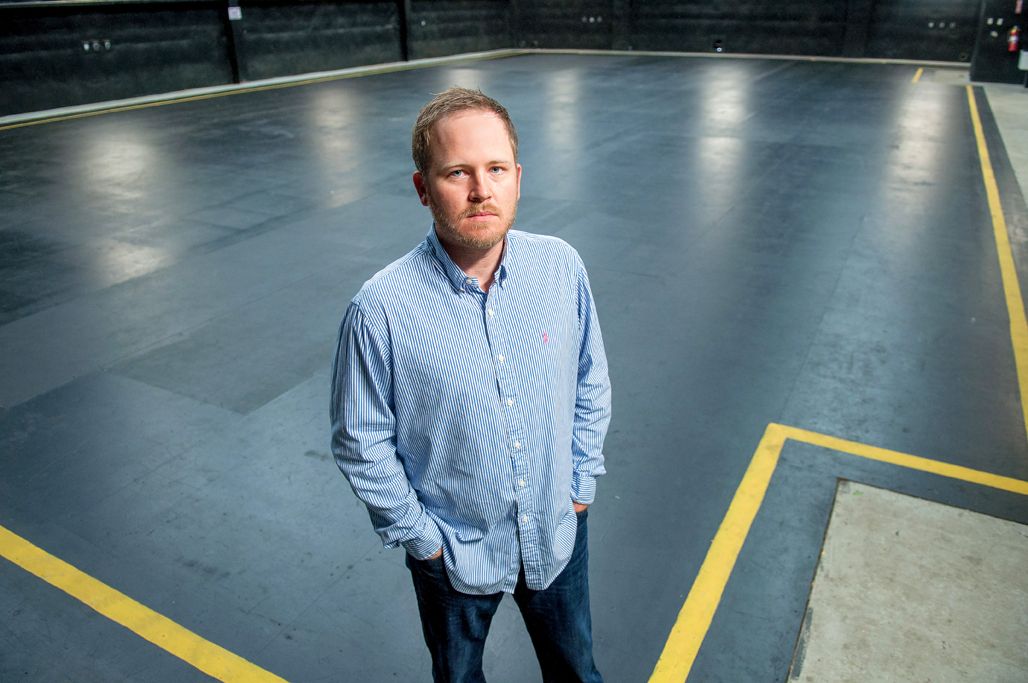Daniel Lewis, COO of Baton Rouge-based Active Entertainment, says film work in Louisiana has dried up to the point where his company is considering looking for work outside of the state—and possibly relocating entirely. Photography by Don Kadair
LSU graduate Daniel Lewis was working as a personal investment banker for J.P. Morgan Chase when he met a client in the film business who had moved from California to Louisiana. After about a year, the relationship led to a job offer.
Lewis was 23 years old, and he might have stayed with J.P. Morgan and moved on to New York. But financing movies seemed a bit more exciting. By 2009 he was COO of Active Entertainment’s Louisiana studio operations. Headquartered in Baton Rouge, his team’s wheelhouse is the $500,000 to $2 million picture, including several made-for-TV movies for Lifetime and Syfy.
Lewis helps provide work for people like Misty Talley, a Lafayette native and the first woman to direct a Syfy original movie, and his own father, who has gone from being unemployed to driving trucks and forklifts for film projects. He says shooting in Louisiana gives Active a selection of many different “looks” beyond the iconic swamps and bayous. And with a little help from modern digital effects, Louisiana cities can even stand in for Chicago, Miami or Los Angeles.
For decades, filmmakers have enjoyed Louisiana’s diverse landscape, hospitality and low cost of doing business. But the state didn’t become “Hollywood South” until lawmakers created a robust incentive program.
Louisiana rewards in-state film productions with tax credits, which can be sold on the open market or back to the state. For Active Entertainment, about 25% of a typical film’s budget depends on the program, Lewis says, and the company has taken out loans with the assumption of being able to quickly monetize those credits.
Last summer, legislators placed new limits on the incentive packages. Predictably, film spending cratered.
The state’s film business is down about 80% since the changes, says Louisiana Economic Development Secretary Don Pierson. Craft workers, creatives and executives are starting to reconsider whether they have a future in Louisiana, and there is reason to fear that years of work and millions of private and taxpayer dollars spent trying to create a permanent local film industry will have gone to waste. Active might start shooting out of state or move altogether.
“It’s not really what we want to do,” Lewis says. “Our commitment is to this state, but at the same time, we’re running a business, and we are at the point where we’re considering alternatives.”
CAPPING THE GROWTH
The cost of the film program varies based on how many movies and TV shows are made here. For the 2014-15 fiscal year, film incentives represented about $213 million of the state’s $8.3 billion in tax exemptions, credits and rebates, according to the Department of Revenue.
While attempting to balance the budget during the chaotic final moments of last year’s session, legislators made a number of film program changes, including limiting the amount of tax credits that can be redeemed in a single fiscal year to $180 million. They also suspended for a year the practice of buying back the credits for 85% of their face value, which was often the quickest way for studios to turn credits into cash.

Capping credit redemptions for three years provided immediate budget relief while helping lawmakers predict the state’s near-future revenue needs. And because the cap didn’t limit the total amount of credits issued—it merely kicked the full cost of paying for them down the road—it jibed with then-Gov. Bobby Jindal’s “revenue neutral” fiscal policy that treated tax credit reductions the same as tax increases.
Other states have capped their incentive programs and seen their film sectors wither. Capping the amount of credits redeemed, rather than issued, is unique to Louisiana, and it’s even worse for the industry, several insiders say.
Implementing the cap without grandfathering in existing credits created a “logjam” that caused a “lack of confidence and stability that’s keeping productions from coming to Louisiana,” says Robert Vosbein, president of the Louisiana Film & Entertainment Association and CEO of Silver Screen Rentals.
“It’s a timing issue,” he says. “We don’t know how many credits are in the pipeline.”
With a front-end cap, at least film producers know for sure whether they qualify for credits or not and can plan accordingly. But when project backers don’t know when they’ll be able to monetize the credits they’ve earned, many would rather invest their money elsewhere.
Chris Stelly is executive director of the state office within LED that oversees the film, digital media, live performance and music programs. He says the state’s total film tax credit exposure is in the neighborhood of $400 million to $450 million, including issued credits and those that are pending review. As of late May, the state had about $75 million of cap space with just over a month left in the fiscal year.
Under current law, the $180 million annual redemption cap will last for three years. So if you combine the $75 million left for this year with $180 million for each of the next two years, that adds up to $435 million worth of credits subject to being claimed through June 30, 2018.
“The cap is quite manageable,” Stelly says, adding that the buyback suspension probably has been a bigger drag on the industry. He says misinformation about the program changes contributed to a “sense of hysteria.”
“What we need is stability,” says Cory Parker, business agent for IATSE Local 478, which represents the craft workers behind the scenes. “There’s confusion in Hollywood because of the [state] tinkering with the program.”
At this time last year, Parker’s whole union was busy. Only about 35% are working today, he says. Many have found work out of state, primarily in Georgia, which has a lucrative, uncapped incentive program and a state government considered firmly supportive by the industry. However, he stresses that films still can get quality crews here.

“We’re not seeing a massive exodus, as some people have suggested,” Parker says. “We do have people that are concerned, and they’re at the point of making that decision for their families and their livelihood.”
Amy Rodrigue manages the Louisiana office of Three Point Capital, which financed several independent films over the past two years. Most of the loans are secured by tax credits.
She says business was quiet immediately after the incentive program changes last summer, but her firm was able to fund two projects in December. Rodrigue says her firm remains confident about the industry’s future in Louisiana.
“It’s still not where it was this time last year,” she says. “I don’t know how long it will take to get back to that, but we’re still seeing some really interesting deals in Louisiana.” For producers, the slowdown has an upside, she suggests, because they don’t have as much competition for a top-tier crew.
Film editor and director Andrew Drazek had no intention of staying in Baton Rouge when he arrived from Los Angeles in 2007 to do some editing for a friend’s company. But after finding there was so much film work available, he ended up buying a house and sticking around. Drazek says the local film business lacks “the unsavory aspects that come with the industry” in Los Angeles.
“People were just interested in the work,” he says. “There wasn’t a lot of [B.S.].”
Drazek spent time last year working in New York and in Spokane, Washington. When he came back to Louisiana in December, he found the work here had dried up and decided to sell his house in Baton Rouge. He has returned to Spokane, and when that job ends, he expects to move back to L.A.
THE BUSINESS CASE
Without getting too deep into the pros and cons of Louisiana’s film subsidies, the political controversy can be summarized in a single sentence: Local governments and businesses reap the benefits, while the state shoulders the costs.
While the state doesn’t even try to calculate a return on investment for many of its programs, LED must issue a detailed report on entertainment incentives every other year. The most recent study by economist Loren Scott says films spurred more than $1 billion in sales for state businesses and almost $728 million in household earnings in 2014, which supporters say is a pretty sweet return on investment for issuing $226 million worth of credits.
Business sectors that benefit include labor; transportation; lodging; car, truck and equipment rentals; gas stations; food and beverage; construction; timber; antique shops; and personal, business and government services.
Film industry participants rented about 17,500 hotel room nights in the Baton Rouge area each year from 2007 to 2015, says Ben Blackwell, president of the Baton Rouge Lodging Association. They’ve probably only booked about 2,000 room nights so far this year.
But Scott also found a net loss for the state treasury of $171 million in 2014. For legislators trying to craft a sustainable budget while protecting education and health care, that’s an important number.
The same dollars could be used to create jobs at universities or hospitals, Scott says in an interview. He cautions that the numbers from his study most often cited publicly are generous estimates that likely overstate how much highly paid actors and directors actually spend in Louisiana.
The state does not report how many Louisiana residents work full-time in the film business. The LED/Loren Scott study says the industry supports about 4,221 direct jobs and 7,886 indirect jobs, which represents estimates of full-time equivalents, not actual workers. Many film jobs are temporary and end when the production wraps, although when times were flush, workers could stay pretty busy by moving from one project to another. IATSE Local 478 has about 1,350 members.
In past years, most of the workers on Louisiana movie sets were brought in from out of state. These days, close to 90% are local, and even the big studio productions often draw 70% or more of their crews from the local talent pool, says Parker, the union business agent.
And you might be surprised by who some of those workers are. For Deepwater Horizon, an upcoming big-budget dramatization of the 2010 Gulf of Mexico disaster starring Mark Wahlberg, 90 unemployed oilfield workers helped build a replica offshore oil rig at the former site of Six Flags New Orleans, Parker says.

Not long ago, Baton Rouge-based Harrison Paint was making $100,000 a month selling to film productions like The Dukes of Hazzard and Green Lantern, says operations manager James Doucet. That business has dried up.
“They were really helpful when they were around,” he says.
Film industry participants rented about 17,500 hotel room nights in the Baton Rouge area each year from 2007 to 2015, says Ben Blackwell, president of the Baton Rouge Lodging Association. They’ve probably only booked about 2,000 room nights so far this year, he says.
“We’re definitely seeing an impact,” Blackwell says. “When you couple that with oil and gas being down, it’s really dramatic.”
It’s hard to quantify how much the film business affects Louisiana’s tourism industry. A 2015 study backed by the Motion Picture Association of America and the state association estimated that 14.5% of leisure visitors from other states were motivated by movies or television shows, although even some industry supporters think that number is unrealistic.
But Louisiana tourism keeps breaking records, and there’s at least some anecdotal evidence that films are a factor. Lorie Bahan Walsh, who directs St. Francisville’s Louisiana Main Street program, recalls a German tourist who came over to visit settings from Beautiful Creatures, which wasn’t a hit domestically but did well overseas. People often don’t realize how many business sectors benefit from a film project, she says.
“It’s a good industry,” Walsh adds. “I hate to see it go.”
AN INCOMPLETE ECOSYSTEM
Louisiana’s film business isn’t dead. The incentive program remains among the most generous in North America, and the infrastructure and crew base hasn’t disappeared.
“We’re still staying super-busy,” says Baton Rouge native Sam Claitor, co-founder of Fable House, a film finance, development, production and distribution company headquartered in Lafayette. But he says some of his friends have had to leave the state or have seen their businesses suffer, and he expects to feel the impact of the slowdown eventually.

Atlanta native Amy Mitchell-Smith was the founding director of the Baton Rouge film commission under Mayor Kip Holden. She left the commission to produce films in 2011 but recently returned to replace Liza Kelso, who resigned last year.
Mitchell-Smith describes Film Baton Rouge as a concierge for local shoots, helping with logistics, lining up insurance and connecting producers with local vendors. The commission also has partnered with the Arts Council of Greater Baton Rouge and New Orleans Video Access Center: Baton Rouge, which launched in 2014, on a youth media program at La Belle Aire Elementary. It’s part of a growing focus on education by local film supporters that includes a pending new screen arts bachelor’s degree program at LSU.
The highest-profile project to shoot in Baton Rouge this year was Jack Reacher: Never Go Back, which stars Tom Cruise and was filmed downtown in January. While the number of film projects has been pretty consistent, Mitchell-Smith says, they’ve mostly been independent productions, not big studio films. Of the three shot in April, one had a budget of about $2 million and the other two planned to spend less than $1 million each.
“We love that sector of the business, because it keeps our crew working,” she says.
Film professionals who leave the state may never return. Supporters hope the current lull is temporary and doesn’t do lingering or permanent damage to the crew base and infrastructure that have been painstakingly built since 2002.
But ideally, you want a healthy ecosystem of indies, TV and $200 million tentpoles, says Celtic Studios Executive Director Patrick Mulhearn. The bigger the film, the bigger the economic impact. And the big movies support the local crew base and infrastructure, which in turn makes the area more attractive for smaller films. A creative who makes her house payment doing editing work for a studio film might then have the luxury to direct her passion project.
Celtic has hosted some of the biggest movies ever shot in Louisiana, including Fantastic Four, Oblivion, and two Twilight movies. But it hasn’t had a big production since August.
“Right now, I would kill for a lot of smaller projects,” Mulhearn says.
He says 39 major productions are shooting in Georgia, mostly in and around Atlanta, compared to five in Louisiana, all in the New Orleans area. And Georgia’s not the only rival. California—after decades of treating the industry as its birthright—has beefed up its own incentive program, while a favorable exchange rate is helping make Canada attractive, to name only two examples.

The Louisiana program changes weren’t all bad for the industry; some were designed to cultivate indigenous Louisiana films.
Local films with budgets as small as $50,000 now can qualify for credits, and additional credits will be available for using Louisiana music, hiring Louisiana residents, and using a screenplay that meets Louisiana ownership requirements. Lawmakers want to encourage homegrown productions that are conceived, written, produced and shot in Louisiana, and perhaps induce existing studios to move here or open a new location.
“That is absolutely wonderful,” says Richie Adams, a writer, director, producer and title sequence designer who could benefit from those changes.
Adams is a Baton Rouge native who went to college in Colorado and worked in Los Angeles before moving back. He returned partly because he missed home and Southern hospitality, but also because he knew he could leverage the incentives to get his own projects off the ground.
“There’s been a lot of negative press about the [tax credit] cap and the program,” he says. While some of the changes may have made the state seem less film-friendly, he says, “Louisiana is still open for business.”
THE NEXT REEL
On May 27, Gov. John Bel Edwards issued the call for this year’s second special session, and nonrefundable tax credits like the ones that benefit film are not on the agenda. For the industry, that’s good news and bad news: The program is safe for another year, but there will be no immediate opportunity to “fix” last year’s changes.
Meanwhile, local film stakeholders are trying to build support. Video testimonials are being created—some attributed to a movement calling itself “Keep Film in Louisiana,” others under the auspices of the state association and the trade union—featuring filmmakers, workers and businesses that benefit from the industry.
Film professionals who leave the state may never return. Supporters hope the current lull is temporary and doesn’t do lingering or permanent damage to the crew base and infrastructure that have been painstakingly built since 2002.
“I’ve spent the past 10 years of my life,” says Mulhearn, counting his time with Celtic and LED, “working to grow something like this.”
Quite a few industry professionals agree there should be a cap on the program to protect Louisiana’s finances. Mulhearn suggests a $180 million front-end issuance cap would be a “win-win,” limiting the state’s financial obligations—which the redemption cap doesn’t necessarily do—while reassuring the industry that those obligations would be met in a timely manner. Stelly says a front-end cap would be compatible with current policy.
The state tax credit buyback program resumes July 1, which might provide a boost. Mulhearn speculates the state might hit its redemption limit for next fiscal year quickly, as credit holders rush to the front of the line, while Stelly doubts that the impact will be dramatic. Independent filmmakers hope the big studios are willing to sit on their credits a while, given that the big guys probably don’t depend on a quick turnaround as much as the indies.

Georgia has a bigger tax base than Louisiana, so if the Peach State really wants to be Hollywood South, it’s going to be hard for Louisiana to reclaim the title. But Mulhearn says it’s still cheaper and easier to film in Baton Rouge than in Atlanta, so Baton Rouge can still compete.
There’s been talk about making the state program more targeted, carving out a niche that might provide a better ROI. For example, Louisiana might draw inspiration from New Mexico’s so-called “Breaking Bad” law and go hard after scripted TV, which tends to have a smaller short-term impact than movies but keeps people working longer.
Brusly native Alicia Allain has been working in the film industry in Louisiana and L.A. since she was 18, and is the former president of Hollywood legend Robert Evans’ production company. She has partnered with John Schneider, best known for his portrayal of Bo Duke on the TV show The Dukes of Hazzard, to open a film studio in Holden.
Allain calls John Schneider Studios an “incubator” for budding independent filmmakers. She says she has been “pounding the drum” for greater support of indigenous filmmaking since 2000.

“We did not, in my opinion, do that as well as we could have, because I can look around the state and see empty boxes,” she says. “We didn’t allow our natural filmmakers to rise up and grow. We looked for Hollywood to come and shake its purse strings.”
But she says that’s starting to change. Schneider echoed those sentiments during a phone call from Georgia on a day off from shooting Tyler Perry’s The Haves and the Have Nots for the Oprah Winfrey Network. When asked what attracts him to Louisiana, he cites the wide selection of possible backdrops, the culture, and the general attitude of the local film community.
“You sit down [to lunch] and you think, ‘My god, this is catering on a film and it’s better than a five-star restaurant in Los Angeles,’” he says. “People are laughing and smiling and having a great time, and enjoying what they do. Nobody’s bitching and griping that they’ve got to carry cable.”
Schneider says $100 million movies are great. But as digital technology evolves, it’s getting cheaper to make a film and easier to deliver it directly to people’s homes, making the big studios and distributors less important.
He believes the real future of film, for Louisiana and the rest of the industry, is small, independent and local.
 GET DAILY REPORT FREE
GET DAILY REPORT FREE








